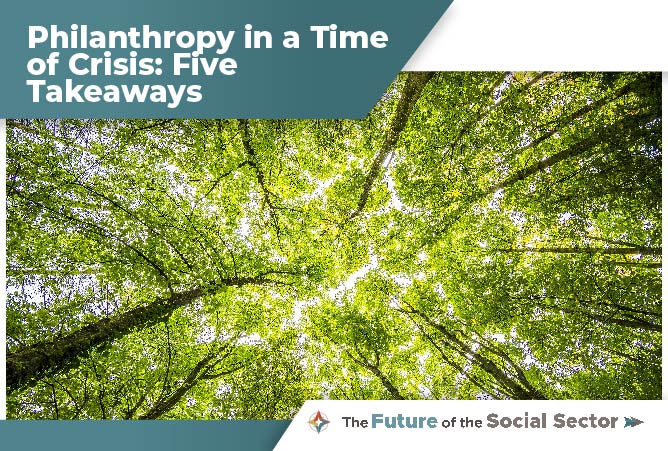Philanthropy in a Time of Crisis: 5 Takeaways

We are living in an era of extraordinary threats and challenges: the weakening of democracies around the globe and the rise of authoritarianism, rapid and unregulated technological change, accelerating inequality that is undermining social cohesion and trust, and a climate emergency that poses an existential threat to humanity.
In the latest webinar in Arabella’s Future of the Social Sector series, Ann Mei Chang, CEO of Candid, and Michele Lawrence Jawando, senior vice president of programs at Omidyar Network, joined Arabella Advisors President Rick Cruz to discuss the role philanthropy can play in this era of crisis. They also considered how the sector must change its culture and practices if it wishes to meet not only this moment, but also the challenges that will define the coming decades. Watch their full conversation, or keep reading for five main highlights.
1. Our crises have deep structural roots. Ann Mei referenced the concept of “disequilibrium”—the idea that many of our institutions and systems are no longer “fit for purpose” and have become incapable of solving the problems we face. In other cases, as Michele pointed out, our institutions are doing exactly what they were (poorly and regrettably) designed to do. Either way, solving our crises will require going well beyond business as usual to drive deep structural and institutional change.
2. Systems change takes time. As Michele put it, “Our systems did not become broken overnight. They aren’t going to be fixed overnight.” Too often, the social sector focuses only on immediate needs or thinks in timeframes (like the three- to five-year strategic plan) that aren’t appropriate for the changes we’re trying to make. As both Michele and Ann Mei stated, we need to play the long game while remaining prepared to seize near-term moments of opportunity when a window for change opens.
3. Our sector can’t solve these problems on its own—but it can and should be a catalyst. Ann Mei explained it this way: “Philanthropy is a tiny, tiny sliver of what businesses and governments do. We have to think of philanthropy as catalytic for addressing both policy failures and market failures.” While philanthropy may lack the scale, resources, and authority to address challenges like the climate crisis or racial injustice on its own, philanthropists do have the luxury of investing in long-term strategies and risky innovations, free from the demands and constraints of constituents or investors. By supporting movements and advocacy, philanthropy and the social sector can also help build public and political will and catalyze government action and market reforms.
4. We must reckon with capitalism. The scale and level of innovation the private sector can unleash can be part of the solution to our challenges, but the way that American capitalism too often currently operates—its extractive nature, its capacity to externalize environmental harms, its tendency to increase inequality that destabilizes our social and political cohesion—is also a deep-seated driver of our current crises. As Michele expressed, transforming capitalism requires long-term work to shift ideas about the economy, the rules by which the economy operates, and strategies for “deconcentrating power” within the economy.
5. We need to be bold. In the face of such challenges, philanthropy needs to be bolder about the scale of our aspirations; about challenging the status quo; about taking risks on promising but unproven ideas and initiatives. As Ann Mei said, “We should be failing more than we are succeeding to be successful.”
To hear more from our panelists, including examples of some of the excellent work already going on across the field, watch the full conversation here . To learn more about how philanthropy can help transform crisis into opportunity, join us as we continue our Future of the Social Sector series over the coming weeks and months.
